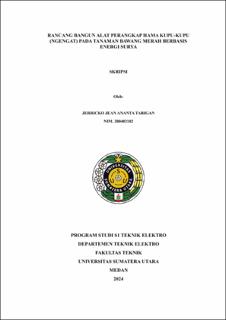| dc.contributor.advisor | Mubarakah, Naemah | |
| dc.contributor.advisor | Bukit, Ferry Rahmat Astianta | |
| dc.contributor.author | Tarigan, Jerricko Jean Ananta | |
| dc.date.accessioned | 2025-03-27T07:27:53Z | |
| dc.date.available | 2025-03-27T07:27:53Z | |
| dc.date.issued | 2024 | |
| dc.identifier.uri | https://repositori.usu.ac.id/handle/123456789/102645 | |
| dc.description.abstract | Shallot is a high-value commodity essential for national consumption, farmer income, and export potential. However, moth pest infestations pose a significant challenge. Farmers commonly rely on pesticides, despite their excessive use potentially causing environmental pollution. In Saran Padang Village, farmers utilize LED lamps and water-filled buckets as moth traps at night. However, limited electricity supply often shortens the operational duration of the lamps. To address this issue, Solar Power Plants (PLTS) offer a sustainable solution to overcome electricity constraints in farming areas and support environmentally friendly pest control methods. This study aims to design and test the effectiveness of solar-powered moth traps for shallot cultivation. The system employs a 50 WP polycrystalline solar panel as the energy source to power blue ultraviolet lamps with three power variations: 9 watts, 11 watts, and 13 watts. The lamps operate for 10 hours nightly, with a testing period of five days for each power setting. The results indicate that lamp power variations significantly influence the number of pests trapped and the effective trap radius. The 13-watt lamp captured the highest number of pests, including 187 Spodoptera exigua and 132 Spodoptera litura, with an effective radius of up to 6 meters. This study demonstrates that increasing ultraviolet lamp power enhances pest capture rates and expands the effective trap range, with the optimal power being 13 watts. | en_US |
| dc.language.iso | id | en_US |
| dc.publisher | Universitas Sumatera Utara | en_US |
| dc.subject | Pest traps | en_US |
| dc.subject | solar energy | en_US |
| dc.subject | shallots | en_US |
| dc.subject | ultraviolet lamps | en_US |
| dc.subject | Spodoptera exigua | en_US |
| dc.subject | Spodoptera litura | en_US |
| dc.subject | Liriomyza chinensis | en_US |
| dc.subject | solar panels | en_US |
| dc.subject | pest control | en_US |
| dc.title | Rancang Bangun Alat Perangkap Hama Kupu-Kupu (Ngengat) pada Tanaman Bawang Merah Berbasis Energi Surya | en_US |
| dc.title.alternative | Design and Construction of a Solar Energy-Based Butterfly (Moth) Pest Trap for Red Onion Plants | en_US |
| dc.type | Thesis | en_US |
| dc.identifier.nim | NIM200402182 | |
| dc.identifier.nidn | NIDN0006057902 | |
| dc.identifier.nidn | NIDN0117098901 | |
| dc.identifier.kodeprodi | KODEPRODI20201#Teknik Elektro | |
| dc.description.pages | 81 Pages | en_US |
| dc.description.type | Skripsi Sarjana | en_US |
| dc.subject.sdgs | SDGs 7. Affordable And Clean Energy | en_US |


